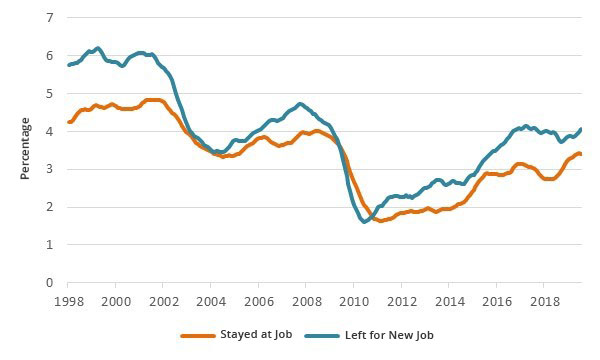Is your employee turnover rate in line with the national average? Or is employee retention a problem for your business?
The US Nonfarm Quit Rate reached its highest level on record on a 12-month moving average basis. On average, 2.3% of workers voluntarily left their jobs each month. However, this trend varies across sectors, with the Manufacturing Quit Rate averaging just 1.6% during the same period.
As a gauge of labor market conditions, a rising quit rate signals rise in employee confidence. Few workers are likely to quit their jobs without a new job lined up, or at least a high level of certainty that they will be able to find a new job.
Wages are an important part of the "why" for people who change jobs. Wage growth for those who remained at their jobs averaged 3.3% during the 12 months through August. In comparison, employees who switched jobs enjoyed a 4.2% increase, on average, with their new salaries. For the firms employing these workers, tight labor market conditions are only exacerbating the tough competition for talent and the margin pressure caused by rising wages.
Median Wage Growth (12-Month Moving Average)

For businesses struggling to hire qualified workers, the economy will not offer relief in the near term. Instead, companies must approach the workforce question differently. We expect tight labor market conditions to persist through at least 2021. In this market, employee retention will be critically important. It will be much easier, and likely less expensive, to retain your existing workers than it will be to find, recruit, hire, and train replacements.
We suggest identifying your top talent and ensuring that your retention efforts meet their needs. In many cases, this means ensuring that your employees are rewarded sufficiently. US Overall Wage Growth reached 3.7% in August. Firms that do not budget for 3-4% annual increases in compensation costs risk being left behind.
Other businesses may find effective strategies for attracting and retaining talent that are not wage-based. These could include monetary benefits such as one-time bonuses or tuition reimbursement, or non-monetary measures such as flexible working arrangements, increased recognition, or other forms of employee outreach. To utilize such strategies, you must know your employees and what they most value. Giving them a free lunch won’t be effective if what they really want is a raise.
Lauren Saidel-Baker
Economist